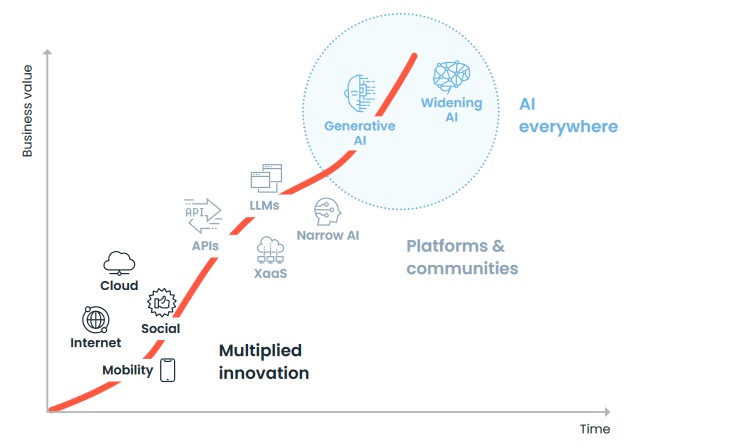In APMdigest's 2025 Predictions Series, industry experts — from analysts and consultants to the top vendors — offer predictions on how Observability and related technologies will evolve and impact business in 2025. Part 3 covers OpenTelemetry, DevOps and more.
OpenTelemetry – The Cornerstone for Observability
In 2025, OpenTelemetry is likely to become a cornerstone technology for observability across the cloud-native and distributed systems landscape. Here's how it might shine: wider standardization across industries, enhanced developer experience, intelligent observability and automation, and ecosystem growth and contributions. In summary, 2025 will likely see OpenTelemetry not only as a tool for observability but as a critical infrastructure component enabling proactive, data-driven operations in modern, distributed systems.
Mehdi Daoudi
CEO and Founder, Catchpoint
OpenTelemetry will cement its place as the standard for telemetry data collection, embraced not only by open-source contributors but also by major commercial players. This will drastically simplify integration, enabling teams to adopt observability practices more easily. The unified approach will lower barriers for new entrants, leading to a proliferation of innovative observability tools tailored to specific use cases.
Andreas Prins
VP of Product Marketing, SUSE
Open source isn't just a cost-saving strategy; it's becoming the primary vehicle for technological innovation in observability. OpenTelemetry, in particular, is transforming how organizations approach instrumentation by providing a vendor-neutral, unified approach to collecting telemetry data across different systems and programming languages. As more organizations recognize the strategic value of OTel, we'll see continued investment, deeper integrations with tools, and even wider spread adoption. There are a few promising areas that OTel is poised to impact in the coming months. One is streamlined troubleshooting — as OpenTelemetry enables teams to correlate metrics, logs, and traces seamlessly, we'll see accelerated root cause analysis and improved system reliability. Another is developer productivity — as standardized instrumentation eliminates the overhead of maintaining custom telemetry solutions, teams will be free to focus on building features. And last is the creation of libraries that provide users with the observability they've been seeking, such as databases, mobile applications, profiling, among many others.
Marylia Gutieerrez
Staff Software Engineer, Grafana Labs
OpenTelemetry opens new paths to value from observability
The industry-wide move to OpenTelemetry's open source agents will make it significantly easier for organizations to switch between observability solutions and update their strategies. Previously, organizations were effectively locked into APM vendors because they'd have to replace proprietary agents across hundreds or thousands of servers — a massive barrier to change. Organizations will extract more value from their observability investments through OpenTelemetry's extensibility. Rather than being limited to basic application performance management, organizations can now layer new capabilities on top of their OpenTelemetry data, pulling extra value from their existing observability investments. This lets teams add new capabilities like architectural documentation and real-time architecture mapping.
Moti Rafalin
CEO and Co-Founder, vFunction
OpenTelemetry Integrates with AI
OpenTelemetry and AI will form a powerful combination. Emerging SDKs will provide observability not only for applications but also for machine learning models, databases, and even the GPUs running those models. Insights into model optimization, prompt engineering, and workload placement on GPUs will become more accessible. Topology-based context will be critical for understanding and optimizing complex AI workflows.
Andreas Prins
VP of Product Marketing, SUSE
Profiles and Traces Converge
While traces and profiles have their unique benefits, 2025 will see their increasing convergence as organizations seek deeper insights into application performance. Traces excel at showing end-to-end request flows, while profiles reveal detailed system resource usage. By combining these tools, teams gain visibility into their applications that manually added spans never could. For example, when a trace shows a 400ms span, corresponding profile data can reveal exactly which code executed during that time period, down to the specific functions and their resource consumption. This allows teams to pinpoint performance bottlenecks with surgical precision, leading to more efficient optimization efforts and reduced operational costs. In the coming years, especially as profiling becomes stable in OpenTelemetry, forward-thinking organizations won't just be collecting traces and profiles — they'll be treating them as interconnected, contextual data streams that provide a holistic view of system performance and efficiency.
Ryan Perry
Principal Product Manager, Grafana Labs
Always-On Monitoring
High availability (HA) clustering with Application Performance Monitoring (APM) tools will become more streamlined and automated, making it easier to maintain continuous monitoring without disruptions. HA clustering solutions will feature improved integration with APM platforms, offering seamless failover, predictive analytics for proactive issue resolution, and reduced setup complexity. Users can expect more self-healing capabilities, where clusters can detect and address performance issues automatically, minimizing manual intervention and ensuring that critical monitoring remains active around the clock.
Cassius Rhue
VP, Customer Experience, SIOS Technology
Third-Party Risk Management
Third-party risk will dominate business continuity planning in 2025 as companies rely more heavily not just on SaaS and cloud providers but also on a complex web of APIs, partner integrations, supply chains, and third-party code. This intricate network means that disruptions from any single vendor — or even a single integration — will have ripple effects across operations, potentially impacting entire supply chains and revenue. To mitigate these risks, proactive, real-time monitoring of all third-party interactions will be critical, with companies demanding full transparency and accountability on performance and recovery plans from all their critical vendors and partners.
Mehdi Daoudi
CEO and Founder, Catchpoint
Website performance meets website observability/security
Website performance will meet website observability/security in 2025, as teams tackle the very intertwined challenges of poorly-monitored third-party scripts in their websites. Website performance management will increasingly depend on better-thought-out observability strategies that monitor how these third-party website scripts behave and impact performance. Given that these client-side attacks target website users' through code script vulnerabilities are increasingly sophisticated and dynamic, teams will need to be more proactive in 2025. Expect teams to deploy proxy environments that pre-screen all third-party code scripts before they reach the live website. These environments will analyze script payloads for performance bottlenecks, suspicious behaviors, and malicious functions. Scripts flagged as dangerous will be automatically blocked from the production environment, while those with performance issues will be flagged for optimization. This more proactive approach to script management will enable teams to deliver faster and safer website experiences in 2025 by preventing problematic scripts.
Simon Wijckmans
CEO, c/side
INCREASED CONVERGENCE OF OBSERVABILITY AND SECURITY
We will see increased integration between observability and security functions in 2025, as organizations work to proactively identify and address digital threats in real time. By combining observability data with strong incident management, companies can better shift from reactive to continuous security approaches, enhancing resilience and operational stability in increasingly complex digital environments.
Gab Menachem
VP ITOM, ServiceNow
Service Integration and Management (SIAM)
As companies manage multiple service providers, Service Integration and Management (SIAM) will become more prominent. ITSM can support the strategy for SIAM and would align multiple vendors in the same boat.
Farooq Hussain
TS Manager Service Support, Information Technology — Technology Services, Qatar Airways
SHIFT-LEFT OBSERVABILITY
By 2025, AI will transform observability in DevOps, enabling teams to anticipate and address potential issues before they impact users. AI-driven monitoring will empower DevOps teams with predictive insights, allowing for faster, more reliable deployments. For this to succeed, transparency will be crucial, ensuring teams can trust and act confidently on AI-generated insights.
Fitz Nowlan
VP of AI and Architecture, SmartBear
Shift-Left Observability Becomes Standard for Developer Efficiency and MTTR Reduction: In 2025, shift-left observability is likely to be a core component of the software development life cycle, streamlining developer workflows and becoming essential for efficient troubleshooting. With growing complexity in microservices, containerized environments, and distributed systems, traditional observability approaches are often too slow to keep pace. By integrating observability earlier in the development process, developers can actively monitor, troubleshoot, and resolve issues before they escalate to production environments, substantially reducing Mean Time to Resolution (MTTR) and enhancing developer experience (DevEx) and productivity. This shift will lead to observability platforms that seamlessly integrate with developers' native environments, empowering them with real-time insights during coding and testing rather than relying solely on post-deployment Application Performance Monitoring (APM) systems.
Leonid Blouvshtein
CTO, Lightrun
Observability will continue its shift left, empowering engineering teams with tools that simplify understanding of workloads without requiring expertise in cloud-native technologies like Kubernetes. Developers and SREs will gain "observability superpowers," through tools and automation, allowing them to troubleshoot, optimize, and secure applications with minimal friction. User-centric observability tools will abstract complexity and focus on delivering actionable insights.
Andreas Prins
VP of Product Marketing, SUSE
DevOps AI Agents
In 2025, we’ll begin to see the adoption of DevOps AI agents, many of whom will completely abstract away the entire incident detection and remediation processes that developers spend so much time on today. Much in the way our kids don’t know what a video cassette is, the next generation of developers won’t know what it means to write a Splunk query, or a Datadog query, or an Amazon Cloudwatch query. They won’t know what it means to pore through logs, or have their eyesight go fuzzy looking at endless charts of metrics; they won’t have occasion to even know what a flame graph is! Rather, they will depend on a team of AI agents, each one an expert at different parts of the incident investigation and remediation process, be that querying and interpreting logs, calculating blast radius by looking at metrics, or looking at change management data to determine broken deployments. They will depend on these agents to collaborate with each other to determine root causes, and to suggest remediation actions that the developers can take.
Deap Ubhi
Co-Founder and CPO, Flip AI
DevOps Supercharges AI-First Infrastructure
DevOps will evolve to meet the unique demands of AI-driven infrastructure, where complex ecosystems of data, machine learning models, and interconnected systems power nearly every industry. This AI ecosystem involves managing vast amounts of data, training and deploying machine learning models, and supporting scalable compute resources—all requiring specialized infrastructure. DevOps teams will expand their role, going beyond workflow automation to fully owning and optimizing these AI-first infrastructures. They'll set best practices for managing the speed, scale, and reliability of AI applications, helping organizations harness AI efficiently and securely as it becomes central to operations.
Mehdi Daoudi
CEO and Founder, Catchpoint





